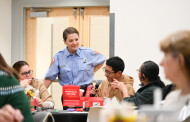The residents of Apex and the surrounding areas have some special neighbors, but don’t expect them to stop by. They prefer a quiet life. Just like many of us, they love where they live and take pride in their homes. It’s just their homes are made of sticks, branches, and pine needles and at least 100 feet up in a tree. These shy neighbors are the majestic and beautiful bald eagles of B. Everett Jordan Lake.
“In all of central North Carolina, it’s the highest density,” said Jon Bannerman, a ranger with the U.S. Army Corps of Engineers, of the lake’s bald eagles.
Year round, about 50 bald eagles call Jordan Lake home and that number jumps to between 75 and 125 when migratory bald eagles arrive during winter. Bald eagles mate for life and the lake is home to at least 25 known pairs, one of the largest breeding populations in the state.
Visitors to the lake can certainly spot bald eagles soaring above, but don’t expect up-close views unless you have binoculars. And, it’s federally prohibited to be within 330 feet (about the size of a football field) of a bald eagle nest.
“They are still a protected bird and they are a bird of national significance,” said Bannerman. If you do have a passion for bald eagles and you want to see them, Jordan Lake is a great place to do so…they are here all the time now.”
If you’re interested in seeing bald eagles and learning more about them, the experts who help manage the lake and monitor these birds of prey have a few suggestions.
First, stop by the lake’s visitor center at 280 State Park Rd., just off Highway 64 in Apex. The center, which is run by the N.C. Division of Parks and Recreation, has a permanent educational exhibit about the lake, including a large section focused on bald eagles. A centerpiece is a stately, artificial tree top capped with a replica nest. There are also details about the individual bald eagles that have called the lake home for years, along with beautiful photography.
Next, enjoy the trails and recreational areas around the lake, especially in the morning when bald eagles like to hunt. The lake’s dam in nearby Moncure, N.C., is a favorite spot for bald eagles to catch their fish for breakfast and dinner. This is an extra popular spot during the winter breeding season. Another good place for spotting bald eagles is near boat ramps because of the wide, unobstructed views of the lake.
The final step, simply be patient and look for a bald eagle to fly overhead or off in the distance. Just be sure to always view the eagles from afar.
“Avoidance is the biggest thing, if you see them,” said Bannerman. “If you have binoculars or even a spotting scope, and you kind of know where they are hanging out or know where a nest is, then find an observation point that is at least 330 feet away.”
During the nesting season, some bald eagles need even greater distance—upwards of 660 feet and more—to feel comfortable. And, they will let their feelings known with alarm calls if they are upset and nervous. “Eagles will do a very good job of telling you, you are too close,” said Bannerman.
Respecting the buffer zone from an active nest is important because a frightened bald eagle pair might abandon their nest, leaving eggs to never hatch or newborn eaglets to starve.
Helping Bald Eagles Soar
Ensuring successful breeding is a priority at Jordan Lake and a part of a larger, national survival story that began decades ago. Bald eagles are unique to North America with a habitat extending from Alaska and Canada through the rest of the U.S. and into northern Mexico, according to information from the U.S. Fish and Wildlife Service.
In 1963, only about 417 nesting pairs were known to exist, according to the fish and wildlife service. Extinction of the national bird was a real possibility. But, with conservation efforts and amendments that strengthened The Bald and Golden Eagle Protection Act, the population slowly rebounded.
“The bald eagle has seen a miraculous recovery over the past 20-30 years and was removed from the list of endangered species,” said Bannerman.
In 2020, the fish and wildlife service estimated 71,400 nesting pairs and 316,700 individual bald eagles in the lower 48 states. These numbers had quadrupled since the agency’s data collection in 2009.
Bannerman explained that Jordan Lake is just the kind of neighborhood bald eagles like—lots of privacy and a large body of shallow water. The lake is surrounded by approximately 13,500 acres of undeveloped land with 180 miles of shoreline.
With the lake’s average depth between 15-20 feet and a maximum depth of 60 feet, bald eagles can easily spot fish to catch while perched in trees and flying overhead. Additionally, the forested acres are filled with tall pines and have an understory that’s thinned out through land management. The understory is the section of smaller trees and shrubs between the forest floor and the forest canopy. When this area is thinned, bald eagles, who are protective of their nesting territory, have a better vantage point for seeing possible threats.
The lake, which was built for flood control, is owned by the U.S. Army Corps of Engineers. The Army Corps leases the land around the lake to the state and those areas are managed by the N.C. Division of Parks and Recreation, the Wildlife Resources Commission and the N.C. Forest Service.
Partnering for Protection
Bannerman manages a bald eagle monitoring team that includes staff from the state partnering agencies and citizen volunteers.
“We have a pretty big volunteer program because we try to get at least one person assigned to each nest and we are close to 100% coverage between our volunteers and our state partners who help out with those nests on their property.”
Among the monitors are friends and bald eagle enthusiasts Steve McMurray and Ellen “Doc” Tinsley. Both are members of the nearby New Hope Audubon Society and have contributed data about the bald eagles since 2011.
Monitoring was a professional responsibility and personal interest for McMurray, who is retiring from his ranger position with the state parks and recreation department this summer. Tinsley, a Fuquay-Varina resident, is a retired veterinarian turned wildlife photographer.
They both love to share stories about the eagles, especially some of the funnier antics, such as stealing fish from other birds and mating pairs “fussing” with each other.
“Eagles are laaaaaazy, capital letters, lazy,” said Tinsley, adding that despite being clever birds and excellent hunters, bald eagles like to lay in wait and steal a fish instead of doing the hard work of catching it themselves. “They actually force an osprey that’s caught its fish, into dropping it.”
McMurray said this kind of interplay is entertaining to watch.
“It’s great entertainment when you get to the lake and are able to see an osprey—because ospreys are so great at hunting. They’ll actually dive for a fish, come up, shake off (the water) and fly off. But then you have the eagles perched on the shore line—they’re watching this and then they will go chase the osprey. The osprey will drop the fish and the (bald eagles) catch it before it touches the water.”
And, McMurray added, that fish still isn’t safe even in a bald eagle’s clutch.
“We’ve seen it where it’s not just one eagle trying to catch the fish, sometimes there are 2, 3, 4, 5 all trying to compete…that fish will change talons or eagles many times.”
Fish are a bald eagle’s preferred food, but Tinsley described them as “opportunists” willing to eat anything that’s easy to get—snakes, frogs, small mammals, turtles and carrion, which is a dead animal. “I’ve seen carcasses—vulture on one end, eagle on the other, both of them happily eating.”
Tinsley, who monitors two nests, began in 2011 with a pair she affectionately named Kate and Petruchio because they shared traits with characters from Shakespeare’s “The Taming of the Shrew.” Kate is the tempestuous female and Petruchio, her patient mate.
“I’ve seen Petruchio bring in a stick (to the nest) that was a good 5 feet long, this big around,” she said while indicating width with her hands. “And, I watched him struggling with it and he finally got it up there…He was so proud he got it in there and he laid it down.
“She looked at him, she looked at it, she looked at him and reached over and bonked him on top of his head (with her beak). Then, she picked up the stick and threw it over the side and he just watched it go.”
It didn’t take long for Tinsley to notice the personalities of the bald eagles on her watch.
“They do have distinct personalities,” she said. “And the males are much more tolerant of the chicks in the nest. The females feed and go, ‘Don’t pester me, don’t bother me. I’ve fed you, leave me alone.’ Dad will go in and start feeding and sometimes will start playing with the babies. I have found that very interesting in an animal that’s supposed to be so fierce.”
Since federal law requires people to stay 330 feet away from nests, monitors must rely on binoculars and spotting scopes to collect data. McMurray said they examine behaviors to gain clues as to what’s happening in the nest.
For instance, nest building is a “tell-tale sign” in late fall that a pair’s particular nest is going to be active, he said. Other behaviors include the eagles assuming a certain posture in the nest indicating egg incubation and dangling small pieces of food into the nest—a sure sign an eaglet was born.
McMurray explained bald eagles mate once a year during winter. Active nesting time starts in December or January and lasts until about May or June. Somewhere between three to seven days after mating, the female typically lays two eggs, rarely three, which hatch about 32 days later.
Even though the birds are an adult size when they leave the nest as fledglings, they are not good hunters and can easily starve, Tinsley explained.
“At about 16 weeks those babies are out on their own,” she said adding that about 50% of fledglings die before they get to be a year old and another 40% die after that.
Some other facts Tinsley and McMurray shared about bald eagles include:
They live for 20-30 years.
They have an average wingspan between 6 and 7.5 feet.
Bald eagles stand about 3 to 4 feet tall—about the size of an average 5 or 6-year-old child.
Females are larger than males.
They are predominantly brown with some white mottling until the distinctive white head and tail fully develop around age five when they typically begin breeding.
Bald eagles mate for life and share in parenting duties, including incubating eggs.
Pairs annually build and repair their nest for breeding season by adding “crib railings” around the top. Nests can range in size from 6-10 feet wide and, over time, 10-12 feet deep, but the actual nesting area is the top 6-8 inches.
Finding A Balance
With Jordan Lake’s popularity—2.5 million visitors last year according to McMurray—the monitoring is an important factor in making decisions that help strike a balance between the bald eagles and recreational activities, especially during the sensitive nesting period.
Jessie Jordan, a Piedmont region biologist with the state parks department said the monitoring data is crucial for making decisions related to the bald eagles. For instance, if an active nest is right next to a boat ramp, the ramp may have to be temporarily closed.
“We all work together to get an idea what the birds are doing, when they’re nesting, what stage of nesting they are in,” she said. “The reality is with Jordan Lake being such a popular place for people to visit, we want to try to make decisions that are least impactful for the birds. Some of that comes down to closures of areas to make sure that the birds aren’t disturbed.”
Jordan noted people can still enjoy the lake while also giving the eagles their space, and Bannerman agrees.
“There’s inevitably going to be more interaction,” he said. “That’s just the nature of it when you have so many people around a burgeoning eagle population.”
So, what can members of the public do to help bald eagles?
First, don’t be what Bannerman described as a “knucklehead.” Basically, don’t try to seek out a nest and get close to it. Anyone who is caught doing so is subject to big fines and possible prison time. Members of the general public aren’t allowed to have drones at the lake, either.
Jordan noted that if you inadvertently find yourself near a nest, quietly leave the area. “Just leave it be and leave the area,” she said, adding it’s important not to disturb the area or remove any materials, such as feathers, on the ground. Bald eagles, their nests and their body parts, such as feathers, are federally protected. Removing plants, animals and animal parts from a state park is also prohibited.
North Carolina doesn’t publish the exact location of bald eagle nests in the state as a protective measure and neither should the public.
“Don’t share the location of the nest on social media or the internet because other people may not respect the (required) distance,” said Jordan.
According to McMurray, the word is out that Jordan Lake has lots of bald eagle nests and it’s caused some problems.
“We have a lot of amateur photographers coming out, trying to get that great photo,” he said. “We don’t know for sure, but we think we may have had a couple of nests that failed due to the public getting too close to get that perfect shot.”
In contrast, sometimes a bald eagle comes to a tree near where you are camping and enjoying the park, especially if the bird is out patrolling and looking for food in its territory.
“If you are stationary and the bald eagle is approaching you, at least briefly, you don’t have to run away. Sit there and enjoy the eagle; it’s probably just passing by.”
Another important tip is to clean up after yourself when visiting the lake. Styrofoam, plastic straw wrappers and fishing line, for example, are choking and tangling hazards for bald eagles and other animals.
“We’re all responsible,” said McMurray. “We all play a part with the lake.”
To Learn More or Volunteer
If you have an interest in the bald eagles and want to volunteer with the monitoring team, contact Bannerman at the lake’s U.S. Army Corps of Engineers office by calling 919-542-4501. Monitoring is conducted regularly during the January-June nesting time.
There are no live webcams at Jordan Lake for viewing bald eagle nesting activity, but there are some around the country, including those at universities with detailed histories and recordings of bald eagle pairs and their young. Check these out:
The American Eagle Foundation (links to cams around the country),
www.eagles.org/what-we-do/educate/live-hd-nest-cams/
Friends of Big Bear Valley, www.friendsofbigbearvalley.org/eagles/
Duke Farms, Museums and Centers of the Doris Duke Foundation, www.dukefarms.org/eagle-cam/
Berry College, www.berry.edu/eaglecam/
East Tennessee State University, www.etsu.edu/cas/biology/eagle-cam/cameras.php








